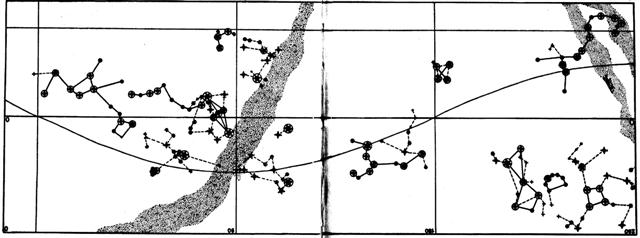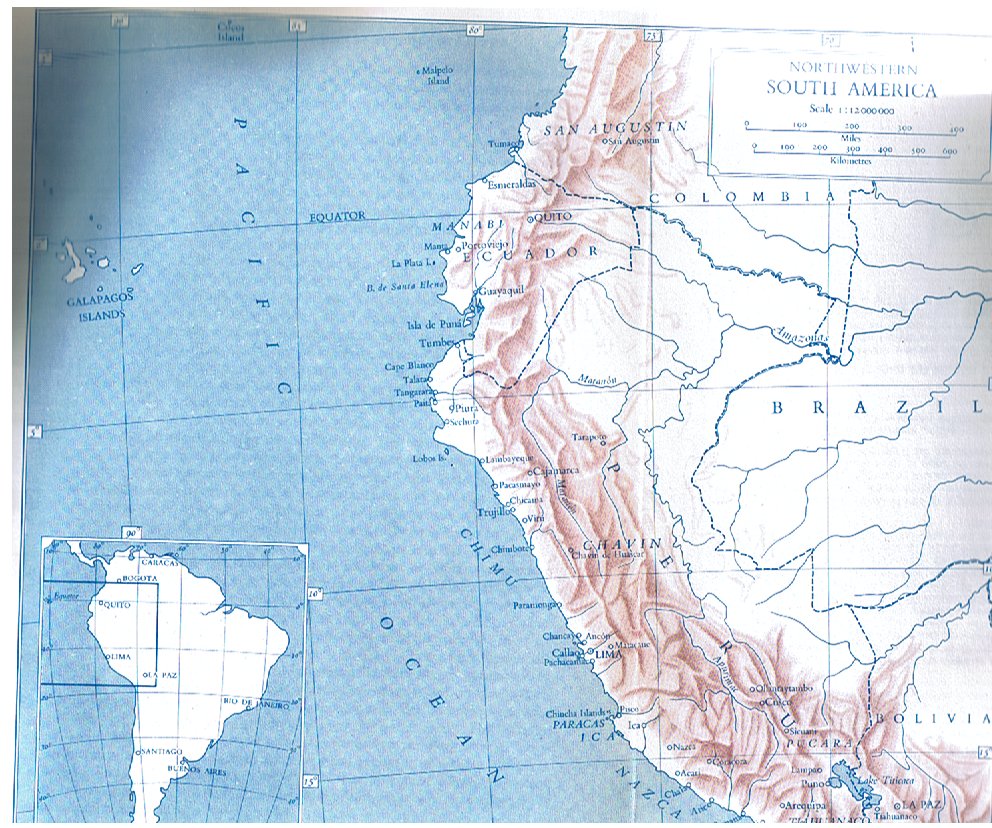|
TRANSLATIONS
As they moved south across the equator the saw the sky (apparently, of course) gliding north. Hercules and Bo÷tes moved further to the north and in order so see them you had to turn around:
I have turned the star map 180░ around, which means that south now is up. Every constellation was now standing on its head. The Lion was upside down below the celestial equator. Looking northwards (with south at your back) means that the 'sky' observed ahead will be above the celestial equator, not below as when you earlier looked southwards with north at your back. As it 'turned out' the 'sky' (above the 'ground' covered by the sun during a year) changed place with the 'water' (below 'ground'). An upside down Lion below the surface of the water (I guess they in South America used the latitude 0░ to define where sky and water met) could no longer be used as a symbol of the sun king - fire is extinguished by water. This kind of reasoning explains why Leo changed name to 'the crab', a creature of the sea. We also remember, from The Raw and the Cooked, that Hercules became 'the pacu fish', while Bo÷tes became 'the piranha fish' and Corona Australis 'the armadillo', a land creature. In the book it is wrongly stated that Corona Australis (the Southern Crown) is located between Hercules and Bo÷tes. There we instead must find Corona Borealis (the Northern Crown). Cetus (the whale) was no longer down in the water and he became the Jaguar, a feline fit to take over from Leo. Though the myths tell about how the jaguar (atugo) lost his fiery eyes and got watery ones instead. '... In order to even things out, the jaguar invited the anteater to a juggling contest, using their eyes removed from the sockets: the anteater's eyes fell back into place, but the jaguar's remained hanging at the top of a tree, and so it became blind. At the request of the anteater, the macuco bird made the jaguar new eyes out of water, and these allowed it to see in the dark. Since that time the jaguar only goes out at night. Having lost fire, it eats meat raw ...' I therefore guess that α Ceti (Menkar) - or γ (which also is marked on the star chart as part of the Jaguar constellation) - must mark the watery eyes; they are north of the celestial equator (i.e. in the 'water'). We check with Allen: "Menkar of the Alphonsine Tables of 1521, Scaliger's Monkar, and now sometimes Menkab, from Al Minhar, the Nose, still is the popular, but inappropriate name, for it marks the Monster's open jaws. It is the prominent star in the northeastern part of the constellation, and culminates on the 21st of December." "Al Kaff al Jidhmah is the Arabs' name for the whole group marking the Whale's head, but in modern lists is exclusively applied to this star [γ]." Because the seasons also 'turned around', Leo ('the crab') - once, a long time ago, located at the hottest time of the year - now became a symbol of the darkest, coolest ('watery') phase of the year. This fact must have been connected in their minds to the fact that they were using a new perspective: back towards south and the 'sky' moved northwards, changing place with the 'water'. It was necessary to use the new perspective to understand the seasons. From the new viewpoint sun now rose at right instead of at left. Because left is connected with woman and right with man it may have been necessary also to shift the ideas about how sun developed. With sun rising at left it would appear natural to regard him as being born from his mother (night - female) at sunrise. With sun rising at right one could continue looking at left and find him descending, of course once again being taken care of by the female - now the caretaker in the west. Maybe this explains why mummification was necessary; there was no new sun born in the east - how could it be a birth in the east without a female? - it was a revitalized sun appearing in the east next morning. Sun was eternal. The new rising of the Pleiades was observed in the evening in autumn north of the equator, while south of the equator the rising had to be done in the morning. New year had to be shifted half a year around. The yearly path of the sun is marked by the curve in the star chart above. It is the same curve as before, but the positions are now reversed. Sun is at spring equinox in September and at autumn equinox in March. In the chart above he moves from left to right. The equinoxes are easily located as the two points where the sun curve crosses the celestial equator (straight line at 0░). Moving from spring equinox to autumn equinox sun travels higher and higher until midsummer (at extreme right in the star chart above). The sun then moves downwards following the curve until he meets the 'water surface' in March, where we find the Jaguar (Cetus). At spring equinox, half a year later, sun appears again above the 'water surface', and there we find Corvus (appropriately in the 'sky') constellation: '... The hero of the Bororo myth [M1] is called Geriguiguiatugo, a name whose possible etymology I have already discussed ... I indicated at that point that the etymology put forward by the Salesians would eventually be confirmed. They break down the name into atugo 'jaguar' (a detail whose significance has been stressed, since the Bororo hero occupies the position of master of fire, like the jaguar in the Ge myths) and geriguigui 'land tortoise' which is also the name of the southern constellation, Corvus. It is therefore possible that Geriguiguiatugo is Corvus, just as Asare is χ Orionis ...' Once again LÚvi-Strauss is careless and refers to the prominent 4-star constellation in the star chart as Cervus ('the flying heron'). According to Allen Cervus is an alternative name for Monoceros, the unicorn, an insignificant constellation close to Orion. However, Monoceros lies across the celestial equator and also on (or very close to) the solstice (winter south of the equator). Interestingly this position is 90░ away from Corvus. The mythical Monoceros beast with one straight - but twisted - long horn may therefore have been quite prominent in the ancient minds. This horn certainly is a kind of tara. As to Corvus we should notice that according to Allen it has moved: "Although now traversed by the 20th degree of south declination, 2000 years ago it lay equally on each side of the celestial equator." Furthermore, when LÚvi-Strauss tell about Cervus as 'the flying heron' he must refer to Indian name, because the latin cervus means 'stag' (another horned beast). So on the star chart his 'Cervus' (the stag, 'the flying heron') is not adjacent to Scorpio ('the big snake') - it is Corvus (Geriguiguiatugo, the land-tortoise-jaguar) which which lies there (at spring equinox). That Corvus is a land-tortoise-jaguar, while Cetus is a jaguar with eyes down in the water should be explained by the equation jaguar = sun; at the equinoxes the constellations have names alluding to the sun. At autumn equinox he is moving head first down into the 'water', at spring equinox he emerges again and - still close to the surface - moves flatly like a tortoise on dry land. Peculiar, though, is the fact that tortoises move so slowly, while at spring equinox the speed of the sun is great. Ca 4,500 BC - by the effects of the precession of the equinoxes - this land-tortoise-jaguar (Corvus) would have been located correctly, i.e. at solstice. North of the equator the constellation would have marked winter solstice and south of the equator summer solstice. Because Corvus was lying across the equator ca 2,000 years ago, we can deduce that Corvus was flying high ca 4,500 BC (north of the equator), and the name may therefore be very ancient. Monoceros would (ca 4,500 BC) be at equinox (spring north of the equator, autumn south of the equator). His horn is certainly a mark and we can 'translate' it as tara. At the 'surface of the water' we must expect some 'needle-sharp bone dagger'. Scorpio is high in the sky, which may explain the idea of a flying fiery snake (close to midsummer south of the equator). '... the great high priest and monarch of the Golden Age in the Toltec city of Tula, the City of the Sun, in ancient Mexico, whose name, Quetzalcoatl, has been read to mean both 'the Feathered Serpent' and 'the Admirable Twin', and who was fair of face and white of beard, was the teacher of the arts to the people of pre-Columbian America, originator of the calendar, and their giver of maize ...' I think I have now explained everything - as far as possible - in a rational way, indeed 'proved' that the latitude 0░ marks the 'water line' and that the back must be towards south when watching the sky (from Easter Island). When watching for the new appearance of the Pleiades (marking new year) it is still the horizon at right which should be studied. But the time must now be morning. One curious fact remains: ancient Mexico (for example) is far north of the equator, not south. How come they venerated a flying fiery snake? With their backs towards north, looking south, Scorpio must be 'below' in the 'water'. I guess the answer may be that they had borrowed the ideas from Tiahuanaco (ca 15░ S).
|

